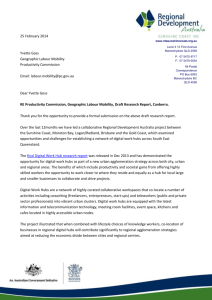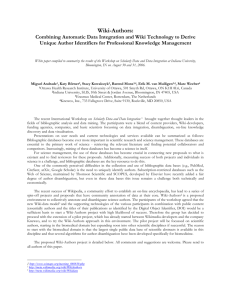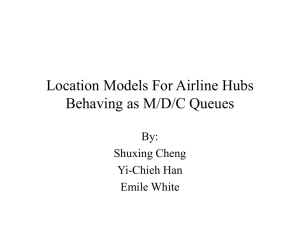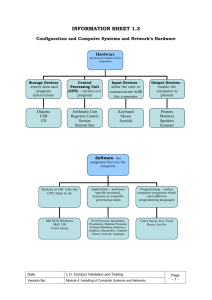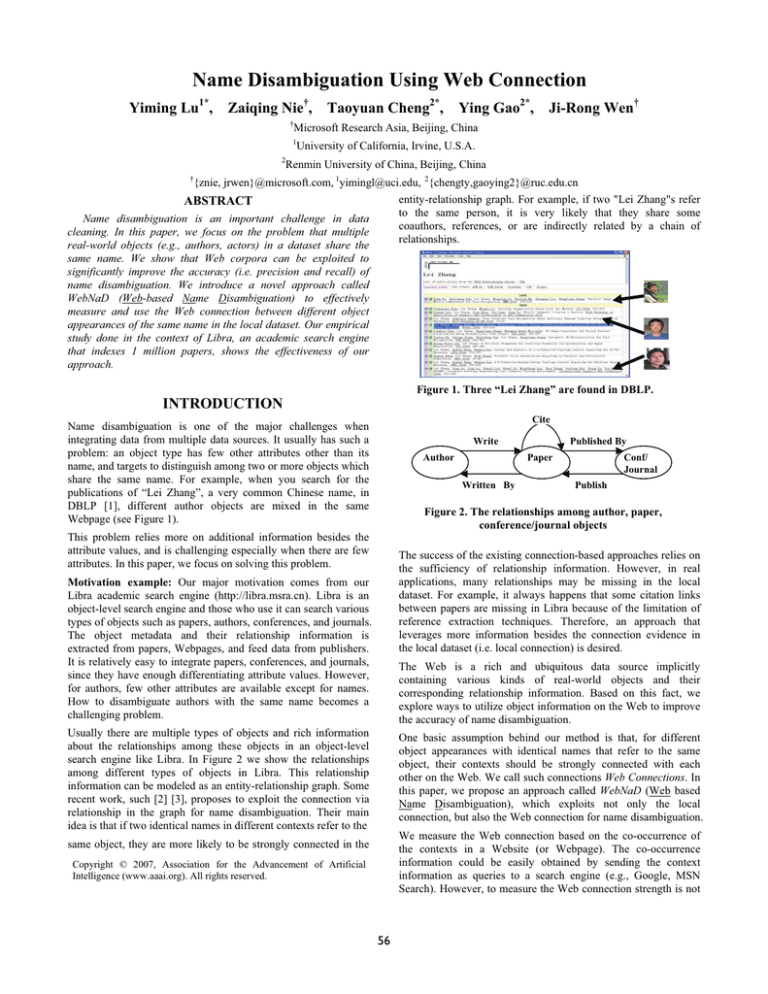
Name Disambiguation Using Web Connection
Yiming Lu1*,
Zaiqing Nie†, Taoyuan Cheng2*,
†
Ying Gao2*,
Ji-Rong Wen†
Microsoft Research Asia, Beijing, China
1
University of California, Irvine, U.S.A.
2
Renmin University of China, Beijing, China
†
{znie, jrwen}@microsoft.com, 1yimingl@uci.edu, 2{chengty,gaoying2}@ruc.edu.cn
entity-relationship graph. For example, if two "Lei Zhang"s refer
ABSTRACT
to the same person, it is very likely that they share some
Name disambiguation is an important challenge in data
coauthors, references, or are indirectly related by a chain of
cleaning. In this paper, we focus on the problem that multiple
relationships.
real-world objects (e.g., authors, actors) in a dataset share the
same name. We show that Web corpora can be exploited to
significantly improve the accuracy (i.e. precision and recall) of
name disambiguation. We introduce a novel approach called
WebNaD (Web-based Name Disambiguation) to effectively
measure and use the Web connection between different object
appearances of the same name in the local dataset. Our empirical
study done in the context of Libra, an academic search engine
that indexes 1 million papers, shows the effectiveness of our
approach.
Figure 1. Three “Lei Zhang” are found in DBLP.
INTRODUCTION
Cite
Name disambiguation is one of the major challenges when
integrating data from multiple data sources. It usually has such a
problem: an object type has few other attributes other than its
name, and targets to distinguish among two or more objects which
share the same name. For example, when you search for the
publications of “Lei Zhang”, a very common Chinese name, in
DBLP [1], different author objects are mixed in the same
Webpage (see Figure 1).
Write
Author
Published By
Paper
Written By
Conf/
Journal
Publish
Figure 2. The relationships among author, paper,
conference/journal objects
This problem relies more on additional information besides the
attribute values, and is challenging especially when there are few
attributes. In this paper, we focus on solving this problem.
The success of the existing connection-based approaches relies on
the sufficiency of relationship information. However, in real
applications, many relationships may be missing in the local
dataset. For example, it always happens that some citation links
between papers are missing in Libra because of the limitation of
reference extraction techniques. Therefore, an approach that
leverages more information besides the connection evidence in
the local dataset (i.e. local connection) is desired.
Motivation example: Our major motivation comes from our
Libra academic search engine (http://libra.msra.cn). Libra is an
object-level search engine and those who use it can search various
types of objects such as papers, authors, conferences, and journals.
The object metadata and their relationship information is
extracted from papers, Webpages, and feed data from publishers.
It is relatively easy to integrate papers, conferences, and journals,
since they have enough differentiating attribute values. However,
for authors, few other attributes are available except for names.
How to disambiguate authors with the same name becomes a
challenging problem.
The Web is a rich and ubiquitous data source implicitly
containing various kinds of real-world objects and their
corresponding relationship information. Based on this fact, we
explore ways to utilize object information on the Web to improve
the accuracy of name disambiguation.
Usually there are multiple types of objects and rich information
about the relationships among these objects in an object-level
search engine like Libra. In Figure 2 we show the relationships
among different types of objects in Libra. This relationship
information can be modeled as an entity-relationship graph. Some
recent work, such [2] [3], proposes to exploit the connection via
relationship in the graph for name disambiguation. Their main
idea is that if two identical names in different contexts refer to the
One basic assumption behind our method is that, for different
object appearances with identical names that refer to the same
object, their contexts should be strongly connected with each
other on the Web. We call such connections Web Connections. In
this paper, we propose an approach called WebNaD (Web based
Name Disambiguation), which exploits not only the local
connection, but also the Web connection for name disambiguation.
We measure the Web connection based on the co-occurrence of
the contexts in a Website (or Webpage). The co-occurrence
information could be easily obtained by sending the context
information as queries to a search engine (e.g., Google, MSN
Search). However, to measure the Web connection strength is not
same object, they are more likely to be strongly connected in the
Copyright © 2007, Association for the Advancement of Artificial
Intelligence (www.aaai.org). All rights reserved.
56
trivial, since co-occurrences in different Websites usually indicate
quite different connection strengths. Even in the same Website,
different co-occurrences need to be discriminated (e.g., cooccurrences in the same Webpage usually indicate stronger
connection than those in different Webpages.).
the correctly detected appearance matches over all the appearance
matches; and recall measures the percentage of correctly detected
appearance matches over all the appearance pairs actually
referring to the same object.
To leverage the Web connection for name disambiguation,
WebNaD extends existing local connection-based approaches by
combining both local and Web connections. Our empirical study
of WebNaD in the context of Libra shows that WebNaD performs
much better than the local connection-based approaches.
Overview of WebNaD Approach
There are several possible ways to detect Web connection. For
instance, we can crawl the Web to construct a Web graph, and if
some hyperlinks (directly or indirectly) connect Webpages
containing the contexts of two appearances, the hyperlink chain
can be considered as Web connection. Another way is to use
sophisticated text mining methods for the content of Webpages to
judge if the contexts of two appearances really correlate. However,
these methods are either very costly, or are complicated,
especially given that a normal user usually have only the search
engine (or Web index) at hand. In this paper, we propose a
relatively practical way to detect Web connection by easily
utilizing the search function of the conventional search engines.
We define the Web occurrence as search results when using some
distinctive information of that object as a query to Web index or
search engine, and define context-object as the directly related
objects of an appearance. For example, if papers P1 and P2 are
authored by one “Lei Zhang”, we can say they are the contextobjects of the two appearances of “Lei Zhang”.
The main contributions of our papers are as follows:
1.
We propose a novel name disambiguation approach that
exploits Web connection evidence in addition to local
connection;
2.
We propose an effective measure of the Web connection
between different object appearances based on their Website
co-occurrences, which could be efficiently obtained by using
a Web index or even a search engine;
3.
An systematic experiment is studied in the context of our
paper search engine ˉLibra.
The rest of paper is organized as follows. In the next section, we
will provide an overview of our problem and WebNaD approach;
in Section 3, we describe the measure of Web connection; in
Section 4, we will summarize the whole framework of WebNaD;
in Section 5, we will show our experiment results in the context of
Libra; Section 6 is a description of related work, and Section 7 is
a conclusion.
Two objects co-occurring in the same Webpage/Website can be
seen as both related to the same Webpage/Website editor (i.e. a
person or an organization) in a certain way, so we can use them as
the Web connections. Intuitively, the Website co-occurrence (i.e.
the co-occurrence in the same Website) is a more general version
of the Webpage co-occurrence (i.e. the co-occurrence in the same
Webpage), and will very likely result in higher recall.
OVERVIEW
Problem Definition
WEB CONNECTION CALCULATION
There are usually multiple types of objects and corresponding
relationships in Libra. However, what we get from our extraction
programs (or from structured data feeds) are usually appearances
(i.e. sets of attribute values) of real-world objects. Each
appearance contains only partial information about an object and
usually has some representative information to denote the object
(e.g., the name of an author, the title of a paper, etc.). Such
information can be seen as a general name of the corresponding
appearance.
In this section, we discuss how to measure the Web connection
between two context-objects based on their Web occurrences. As
mentioned in the overview section, Website co-occurrences will
produce higher recall, and Webpage co-occurrences can be treated
as specific cases of Website co-occurrences, so we focus on how
to effectively measure Web connection based on Website cooccurrences in this section. We first discuss how to calculate the
site-level Web connection (i.e. the Web connection at a given site)
(Section 3.1). Then, we introduce how to calculate the Web
connection strength by combining of site-level connections at
different sites (Section 3.2 and 3.3). After that, we discuss how
to deal with the practical issues in using Web connection (Section
3.4).
For some object types, such as paper, conference and journal,
names are discriminative enough and each name will very likely
refer to a single object. However, for some other object types,
such as author, simply grouping appearances sharing the same
name will falsely merge information of different objects (false
positives). For those object types, we need to first detect the
ambiguous names (i.e., the names referring to multiple objects),
and then do the disambiguation for those names.
Site-level Web Connection Calculation
A natural way to measure the site-level connection between the
For all the appearances sharing a certain name, the goal of name
disambiguation is to partition them so that each partition
corresponds to an object in the real world, while different
partitions correspond to different objects. Putting any two
appearances in the same partition is called as a match.
context-objects o1 and
We evaluate the quality of name disambiguation by precision and
recall. For a certain name, precision measures the percentage of
However, this measurement is imprecise in terms of all the cooccurrences at a certain site having the same connection strength.
cs (o1, o2 )
57
O2
in a certain site s is as follows:
­1, if o1 and o2 co-occur in site s
®
¯ 0,otherwise
A simple example is that co-occurrence in a page tends to show
stronger connection than two occurrences in different pages.
Linear Combination of Site-level Web
Connections
To discriminate different co-occurrences in a given site, we
propose to take into account the URL distance between the two
Web occurrences in the Website.
To combine the site-level connections at different sites, it should
be noticed that not all sites play the same role for name
disambiguation. In our "Lei Zhang" example, we may find two
Website
co-occurrences
of
papers.
One
is
http://research.microsoft.com/, the Website of Microsoft Research,
while the other one is DBLP [1]. Although the two sites both
represent an academic community, the former co-occurrence
usually provide stronger connection for a match. This is because
the former one shows that two "Lei Zhang"s are probably both the
members of Microsoft, a relatively small community, while the
latter one only shows that they both work in the computer science
domain.
The logical organization of a Website can be seen as a hierarchy,
and the URL of a Webpage is an indicator of its logical position
in the hierarchy structure. A URL is split by slashes into several
layers, and each layer can be considered the name of a domain, a
directory or a file. The editor of the Website usually tends to put
similar Webpages as near as possible in the hierarchy structure,
therefore we assume that with more layer matches in two URLs, a
stronger connection can be indicated. For instance, in our "Lei
Zhang" example, the co-occurrences whose URLs share the prefix
http://wotan.liu.edu/docis/dbl/acmmmm/
indicates
stronger
connection evidence than the co-occurrences whose URLs only
share http://wotan.liu.edu/docis/dbl/, because the former one may
shows that two "Lei Zhang"s are both related to the ACM
Multimedia Conference, a much smaller community than the
whole computer science community.
Intuitively, for a given object type, the fewer objects one site
contains, the more connection evidence can be indicated if two
context-objects co-occur in it. This shares a similar idea as the
IDF in the information retrieval field. Thus, we introduce the
concept of coverage of a site:
Definition 3.1. Given a certain type of object set C, the coverage
score of each site S is:
Therefore, we can measure the distance between u1 and u2 with
layer matches, and use the total number of layers of u1 and u2
for normalization. The calculation is shown as follows:
Sim ( u1 , u 2 )
{ x | x C , x occurs in S }
cov erage( S )
2 l m atched
( llayer 1 llayer 2 )
With this concept, given n Websites, a straightforward way to
combine site-level connection between O1 and O2 of different
sites is a linear combination using the inverse coverage score of
each site, as follows:
where
z
Sim(u1, u2 ) is the similarity of u1 and u 2 based on
URL layers, and indicates the distance of u1 and u 2 in
the hierarchy structure of a Website;
z
llayer1 , llayer 2 are the length of layers of u1 and u2 ;
z
lmatched is the length of matched layers of u1 and u2 .
n
C o n n ( O1 , O 2 )
O2
sws
where
z
z
at site s as
z
C onn ( O1 , O 2 ) represents the Web connection score of
context-objects O 1 and O 2 ;
c s is the site-level connection between O1 and O2 of
site s ;
w s indicates the inverse coverage of site s ,
1
.
w
s
cs (o1, o2 )
¦c
s 1
Given the similarity based on URLs, we can define a site-level
connection between the context-objects o1 and
follows:
{ x | x C}
Max ( Sim(u j , uk )) , which satisfy that o1 occurs in
cov erage ( s )
u j ,uk
page u j , O 2 occurs in page uk , and u j , uk are both in site s .
A Learning Approach to Web Connection
Calculation
Obviously, if o1 and O 2 co-occur in the same Webpage, we can
get maximum site-level connection at that site (i.e. the URL
distance is equal to 1).
The linear combination approach in the above section is
problematic: for the purpose of name disambiguation, the relative
importance of each site is usually domain-specific and not exactly
proportional to the inverse coverage score. For example, in our
dataset, www.cs.cmu.edu has much more coverage than
www.springerlink.com, but it is obvious that co-occurrence in the
publications of CMU provides stronger connection than the cooccurrence in the paper collection of springerLink, an online
paper search portal. Thus simply using the inverse coverage score
for combination may not be reasonable for the name
disambiguation purpose. A more adaptive combination could be
learned if a set of pairs, each of which are labeled as either a
match or non-match, are available.
Some sites may use a nearly flat schema with numerical
identifiers, such as http://portal.acm.org, and URL distance seems
not a good indicator of similarity in such case. However, we argue
that it could be interpreted that all the occurrence pairs are with
the same similarity in the site editor’s eye. In the next two
subsections, we will introduce two novel ways of combining the
site-level connections by weighting the Websites unequally.
58
Actually, the essential in using site-level connection for name
disambiguation is to determine whether the Website cooccurrences indicate strong enough connection to match the
corresponding appearance pair. This is essentially a binary
classification problem. If we use a feature vector p ( O1 , O 2 ) , in
which each dimension is the Web connection between the
context-objects O1 and O2 in one of the sites, to represent a
context-object pair, the task can be formalized as follows:
p ( O1 , O 2 )
where
site s .
cs
ones with high coverage; while the “massive many” are the sites
which rarely contain papers. The discovered sites with relatively
higher coverage are not surprising: many of them are the Websites
which provide paper search service or the Websites of prestigious
research organizations.
Second, although co-occurrences of two context-objects in
different sites are of different importance for name
disambiguation and are not necessarily proportional to the inverse
coverage score, we find that co-occurrences of context-objects in
sites with extremely low coverage score (i.e., the sites whose
coverage scores are below a certain threshold) always provide
strong enough evidence for a correct match. For example, if two
papers "Emergent Semantics from Folksonomies: A Quantitative
Study" and "Integrating Web Services into Ontology-based Web
Portal" can both be found in http://apex.sjtu.edu.cn/, a site of a
research lab focusing on knowledge management, then the "Lei
Zhang" of those two papers will most likely refer to the same
person. For the purpose of convenience, we call these sites as
small hubs, while the ones with high coverage score are called as
big hubs.
c s o 1, 1
is the site-level connection between O1 and O2 at
For this binary classification task, we choose support vector
machine (SVM) [4] for this classification task because of its
learning capability from limited training sets of high-dimensional
data and resilience of noise.
SVM is based on the idea of structural risk minimization rather
than empirical risk minimization. It maps the input vectors to a
high-dimensional space, and applies a hyperplane which leaves
the maximum margin between two classes. Given a labeled
/RJ1XPEHURI6LWHV
training data set D { X i , yi }it 1 , where yi {1, 1} , the
corresponding decision function of SVM has the following form:
t
f (X )
sign ( ¦ D i y i K ( X i , X ) b )
i 1
where K is the kernel function. The typical kernel functions
include polynomial kernel, Gaussian RBF (radial basis function)
kernel, sigmoid kernel.
O1 , O 2 /RJ3DSHU)UHTXHQF\
Figure 3. Power Law Distribution of Paper Frequencies of
Websites.
1XPEHURI'LVFRYHUHG%LJ
+XEV
f (P
For name disambiguation problem, the prediction score of the
decision function can be seen as the confidence whether the
corresponding appearance pair are of the same object. Thus, if a
set of training data labeled as either match or non-match is
available, the Web connection between O1 and O2 can be
measured by the prediction score, as follows:
C o n n ( O1 , O 2 )
)
This learned Web connection function will give more weight to
those sites in which the co-occurrence indicates stronger evidence
for match.
1XPEHURI3UREHV
Figure 4. The Growth of Big hub (>1%) Numbers by
Randomly Probing
Practical Considerations
There are still some issues in computing the site-level Web
connection. First, when only a search engine is given, all the Web
sites are "hidden" behind the search interface, and cannot be
obtained beforehand. Second, even if all the Web sites are known
beforehand (e.g., we have already indexed the Web corpora
locally), there are usually billions of Web sites in Web corpora,
and to train a connection function for such a high dimension is
nearly out of the question in practical.
Assumption 3.1: For two appearances sharing a given name
A1 , A2 , if their context-objects are found to co-occur in one of the
small hubs (whose coverage scores are below a certain threshold),
A1 , A2 will most likely refer to the same object.
To deal with these issues, we first present some useful
observations on the Web corpora according to a study in Libra.
The assumption above is always valid if the threshold is set
conservative enough.
First of all, for a given type of objects, the coverage distribution
of each site usually obeys a power-law distribution. By the study
on the distribution of around 1 million papers of Libra in the Web
corpora (using the paper titles to get the Web occurrences of
paper objects), as illustrated in Figure 3, only a few sites are the
Third, it is feasible to discover the big hubs for a certain type with
few times of probing. Figure 4 shows the growth of the number of
newly discovered big hubs (i.e. Websites with coverage scores
greater than 1%) when we probe paper titles to Web corpora. We
observe that the newly discovered big hubs tends to converge
Based on the prior observations, we can make the following
assumption for name disambiguation:
59
corresponding authors and conferences/journals, crawled from
several Web datasets. For authors, author appearances extracted
from many data sources only contains name information, and
name disambiguation is one of the major challenges in integration.
after only around 600 probes of papers, while there are around 1
million papers in our dataset. Note that the sample papers for
probing are randomly selected, and there is no bias in it.
Given the above three observations, we can determine an
appearance pair as referring to the same object once their contextobjects are found in a small hub. The adaptive site-level
connection function described in the above subsections is only for
the co-occurrences in big hubs. As shown in the above
observation, the number of big hubs is relatively limited, so it
becomes feasible to train an adaptive connection function which
gives a suitable weight to the co-occurrence in each big hub.
We use 9,330 distinct author names out of 651,228 for
disambiguation. From those names, 120 distinct author names
(9,559 appearances in total) of 201 different authors are labeled.
Around 2/3 appearances are randomly selected for training and
1/3 are left for testing.
Sample Context
Objects
Sample
Probing
To determine the coverage threshold for small hubs, we can
simply use the co-occurrence in small hubs for name
disambiguation in the labeled sample dataset. With different
coverage threshold setting, we observe the precision result.
Generally, the higher the coverage threshold is, the lower the
precision will be. To make Assumption 3.1 stand, we usually set a
relatively conservative threshold.
The site-level connection at big hubs of one contextobject pair is above a pre-defined threshold (Big Hub
Connection Model);
Small
Hub
Con
Rule
Big
Hub
Con
Model
detected
matches
Figure 5. The WebNaD Procedure
We use Delivered Current Model [5] to measure the local
connection evidence, and use paper’s title as the query for search
engine to get the Web occurrence.
In our experiment, we measure the overall performance with
precision and recall of the match, as defined in the overview
section, and use F score to harmonize them as the following:
During the Probing phase, we obtained the corresponding big
hubs by probing the context-objects. During the Training phase,
given the big hub set obtained in Probing phase, an adaptive
combination for site-level connection at big hubs is learned.
During the Disambiguation for a certain name, any appearance
pair X 1 , X 2 will be detected as a match once they satisfy one of
the following conditions:
z
Local
Con
Name
Disambiguation
The whole process of our WebNaD approach composes three
phases: Probing, Training, Name Disambiguation, as shown in
figure 5.
One context-object pair is found to co-occur in a certain
small hub (Small Hub Connection Rule);
Big Hub
Set
Big Hub
Set
WebNaD Approach
z
Big Hub
Set
Big
Hub
Con
Model
Training
To get the big hub sets for an adaptive Web connection function,
we only need to discover them by a few times of probing of
context-objects.
The connection strength in local data set is above a predefined threshold (Local Connection);
Trained By
SVM
Training Data
Appearance pairs
z
Sample Probing
F score
2 * prec * recall
prec recall
Study on Web Connection Measures
The Small Hub Threshold Setting: With different small hub
threshold settings (coverage threshold), we observe the number of
big hubs and the accuracy (i.e., the precision and recall). Table 1
shows the result. As we might have predicted, with a lower small
hub threshold, more big hubs can be obtained, and higher
precision can be reached, while the recall becomes lower. How to
determine the threshold is a trade off. However, as we can see,
when the threshold exceeds 1%, the precision for using Web
connection in small hubs has a sharp decrease. A reasonable small
hub threshold setting in our experiment should not exceed 1%. In
the following experiments, the small hub threshold settings are set
to 1%.
Finally, to complete the disambiguation phase, we compute the
transitive closure of the appearance matches based on the
transitive assumption: if X 1 and X2 refer to the same object, and
X 2 and X 3 refer to the same object, then X 1 and X 3 should also
refer to the same object even if their connection strength is not
strong enough.
Web connection at Big Hubs: To study the Web connection at
big hubs, we have compared four different measures:
z
z
EXPERIMENTS
z
Experimental Setup
z
Libra currently has indexed more than 1 million papers and their
60
"Learnable+URL": Learnable combination considering the
distance of URL layers. This is the calculation of site-level
Web connection at big hubs in WebNaD.
"Learnable": Learnable combination simply based on the
co-occurrence at site level without considering the distance
of URL layers.
"Linear+URL": Simply linear combination of distance of
URL layers, using the inverse coverage score as the weight.
"Linear": Simply linear combination of co-occurrence at site
level, using the inverse coverage scores as the weight.
The kernel used in SVM is the RBF kernel, and we just use the
site-level connection in big hubs for author name disambiguation.
approaches couldn’t work for scenarios where there are few
attribute values available for disambiguation.
Table 1. Accuracy by only using Web connection in small
hubs and the number of big hubs with different small hub
threshold settings
Threshold(%)
Precision
Recall
# of BigHubs
0.1
0.994
0.350
6363
0.2
0.935
0.432
2852
0.5
0.918
0.568
1009
1
0.906
0.703
448
2
0.625
0.767
199
5
0.603
0.801
72
10
0.588
0.876
42
Recently, the relationship information among different types of
objects in a local dataset has started to be exploited for name
disambiguation, such as [2][3]. The limitation of these approaches
is that they rely too much on the completeness of relationship
information, and will probably result in low recall.
In contrast, WebNaD exploits the local connection and the rich
Web connection, and results in high recall.
Table 3. Accuracy comparison of different approaches
Approach
Precision
Recall
F-score
Table 2. Maximum F score of four Web connection
measures at big hubs.
Measures
F-score
Learnable+URL
0.773
Learnable
0.675
Linear+URL
0.621
Linear
0.622
Table 2 shows the optimal F score of the four measures. Note
that the relatively lower F score is due to our ignoring the Web
connection in small hubs and the local connection in this
experiment. Obviously, the "Learnable+URL" by far
outperformed other three measures, because of the learnable
relative importance of each site and consideration of URL layer
distance.
Name Match
0.436
1
0.607
Local (1)
0.668
0.396
0.497
Local (2)
0.902
0.254
0.397
WebNaD
0.878
0.892
0.885
WebNaD(Page)
0.889
0.636
0.741
CONCLUSION AND FUTURE WORK
In this paper, we study the name disambiguation problem in the
scenario that there are few attribute values and one name may
correspond to multiple objects. We show that the Web corpora
can be exploited to significantly improve the accuracy of name
disambiguation. We introduce a novel approach called WebNaD
to effectively measure and use the Web connection for name
disambiguation.
Study of WebNaD
Comparison with Previous Approaches: Table 3 summarizes
the overall performance of different approaches for name
disambiguation: WebNaD, WebNaD(page), Name Match, and the
local connection-based approach[2]. Among them, the Name
Match approach is the integration that ignores the disambiguation
(i.e. simply grouping the appearances sharing the same name, and
obviously the recall is 1). WebNaD(Page) uses page-level
connection instead of site-level connection in the disambiguation.
For the local connection-based approach, we show two results
with different threshold setting: Local (1) is the result when
approximately reaching the optimal F score ; Local (2) is the
result when the precision is similar to the optimal result of the
WebNaD.
REFERENCES
[1] DBLP. http://dblp.uni-trier.de/
[2] Z. Chen, D.V. Kalashnikov, and S. Mehrotra. Exploiting
relationships for object consolidation. In ACM IQIS, 2005.
[3] X. Dong, A. Halevy, and J. Madhavan. Reference
econciliation in Complex Information Spaces. In Proc. Of
SIGMOD, 2005.
[4] V. Vapnik. Principles of risk minimization for learning
theory. Advances in Neural Information Processing Systems
3, pages 831-838. Morgan Kaufmann, 1992.
[5] C. Faloutsos, K. McCurley, and A. Tomkins. Fast discovery
of connection subgraphs. In Proc. Of SIGKDD, 2004.
Due to the insufficiency of relationship information in the local
dataset, we can see that the optimal result of the local connectionbased approach is even worse than the result of Name Match.
From the comparison of Local (2) and WebNaD, we can see that
by leveraging the Web connection, the recall improves a lot (from
0.254 to 0.892), while not sacrificing much in precision. As we
can predict, the WebNaD results are much higher in recall than
those of WebNaD(Page).
[6] W. E. Winkler. The state of record linkage and current
research problems. Technical report, Statistical Research
Division, U.S. Bureau of the Census, Washington, DC, 1999.
[7] A. Monge, and C. Elkan. An efficient domain independent
algorithm for detecting approximately duplicate dataset
records. In DMKD, 1997.
[8] A. McCallum, K. Nigam, and L. H. Ungar. Efficient
Clustering of High-Dimensional Data Sets with Application
to Reference Matching. In Proc. Of SIGKDD, 2000.
RELATED WORK
[9] L. Jin, C. Li, and S. Mehrotra. Efficient record linkage in
large data sets. In DASFAA 2003.
The traditional work on name disambiguation is usually based on
the string similarity of the attribute value [6][7][8][9]. These
61


